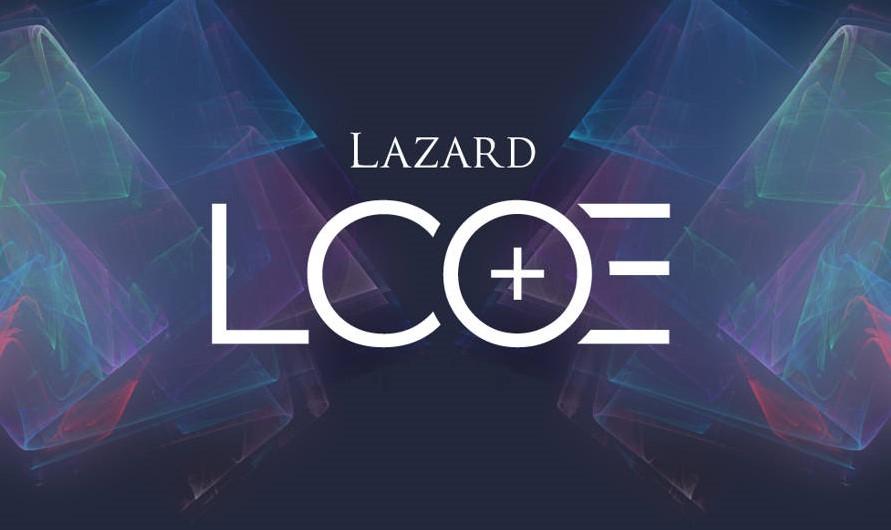The Latest Numbers From Lazard on the Levelized Cost of Energy
By: John A. Lanier

Audio File
Hey, hey, look! It’s here, it’s here! It’s been a long year-and-a-half, but we finally have the latest levelized cost of energy report from Lazard. I realize you may not be as excited about this as I am, but it’s one of my favorite nerdy climate reports, right up there with those from the Intergovernmental Panel on Climate Change. Click your brain into gear, because we are diving headfirst into the weeds.
Levelized Cost of Energy Explained
Here is Lazard’s webpage for the report and a direct link to the PDF. You’ll want to open up the PDF in a new tab and be ready to do some clicking back and forth. But first, let me explain what in the heck Lazard is doing when they publish these reports.
The levelized cost of energy (LCOE) refers to the average net present cost of producing energy in different ways. It can be expressed either as an average number or as a range of costs. In other words, when you see the LCOE of, for instance, offshore wind turbines, you are seeing what it generally costs to add that form of electricity generation to the grid. Because those costs are normalized per unit of energy, an LCOE report that looks at different forms of energy generation can tell you the relative costs of each form. Not surprisingly, LCOE analyses can range widely in different regions of the world, but Lazard’s 2023 report focuses specifically on LCOE in the United States.
The Cheapest Form of Energy, and Other Takeaways
Okay, let’s look first at page 5 of the report (numbered page 2 in the bottom right). This is the “main course” of the LCOE report, and it tells us the range of unsubsidized costs by generation type. Various forms of renewable energy are at the top, compared to the four types of nonrenewable energy at the bottom. When you see a dark blue bar, that’s a range of costs based on robust observable data. The gray bars for geothermal, nuclear, and coal are estimated ranges of costs, because we do not have sufficient new installations of these forms of energy generation to base their LCOE on recent data.
Here are my takeaways from this chart:
- Onshore wind! It’s the winner here, with average costs that are clearly lower than combined cycle natural gas.
- Utility scale-solar is roughly cost competitive with natural gas, averaging a bit cheaper on its own and a bit pricier when you factor in storage.
- Rooftop solar is expensive, but it’s the orange compared to all of the other apples here. Most rooftop solar that is being installed is by homeowners, whereas the other forms of electricity are being installed by large businesses. If I want to generate electricity at my home, I can’t build a wind farm or a natural gas plant, so it’s not terribly relevant that rooftop solar costs more. And for many people, rooftop solar still pencils out with a positive return on investment at current prices.
- Do you see those three yellow diamonds on the lines for nuclear, coal, and natural gas? Those show the average cost of operating those forms of energy generation, as opposed to building new ones. Between wind and utility-scale solar, it’s fair to say that in some cases, it’s cheaper to build new renewable energy than to operate existing nonrenewable power plants.
- Admittedly, the cheapest renewables have the challenge of intermittency (because the wind doesn’t always blow and the sun doesn’t always shine). That emphasizes the importance of grid-scale storage technologies, because we will need robust energy storage to displace the forms of energy that provide baseload electricity. These charts show that renewables are now winning on cost, and we just need them to win on performance to make fossil fuel electricity fully obsolete.
A Layer Deeper in the LCOE Report
Okay, let’s go to the next chart (PDF page 6, numbered page 3 in the bottom right). That first chart showed unsubsidized costs, but we know that federal policies like the Inflation Reduction Act are providing “carrots” for the transition to a low-carbon economy. If you look at this chart, you see that federal tax subsidies make already-cheap renewables that much cheaper. The shift for rooftop solar is particularly large, and it further justifies my point above that the math for rooftop solar works for many individual homeowners.
Next, take a peak at PDF page 13, numbered page 10 in the bottom right. This shows the historical decline in the LCOE of wind and solar. It really is remarkable how much cost decline we have seen in a little more than a decade. Also, this report is the first time that Lazard has seen an increase in the LCOE of wind and solar. The high inflation of the last couple of years has definitely impacted these markets, but it’s also impacted other forms of electricity generation as well. Adjusted for inflation, I would expect wind and solar to continue seeing small, marginal declines in LCOE for the next several years.
Finally, take a look at PDF pages 15 and 16 (numbered 12 and 13 in the bottom right). These slides show the component parts of the LCOE for each generation type, with the first slide looking at the low end of costs and the second slide looking at the high end. What’s remarkable to me is just how significant the fuel costs are for nonrenewable sources of electricity. So let this be your friendly reminder that the sun and wind don’t charge us a cent for the energy they provide.
There’s a ton more to see in this LCOE report if you are so inclined. In particular, Lazard offers in-depth cost analysis of both energy storage technologies and hydrogen production technologies. Happy reading, and I’ll be sure to revisit Lazard’s LCOE reports in future years.

